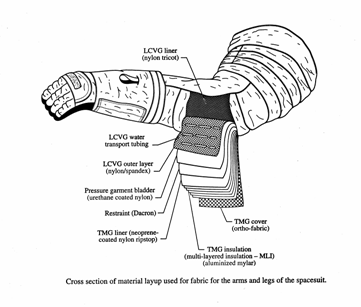Thermal Micrometeoroid Garment on:
[Wikipedia]
[Google]
[Amazon]
 An (Integrated) Thermal Micrometeoroid Garment (TMG or ITMG) is the outer layer of a space suit. The TMG has three functions: to insulate the suit occupant and prevent heat loss, to shield the occupant from harmful solar radiation, and to protect the astronaut from
An (Integrated) Thermal Micrometeoroid Garment (TMG or ITMG) is the outer layer of a space suit. The TMG has three functions: to insulate the suit occupant and prevent heat loss, to shield the occupant from harmful solar radiation, and to protect the astronaut from
 An (Integrated) Thermal Micrometeoroid Garment (TMG or ITMG) is the outer layer of a space suit. The TMG has three functions: to insulate the suit occupant and prevent heat loss, to shield the occupant from harmful solar radiation, and to protect the astronaut from
An (Integrated) Thermal Micrometeoroid Garment (TMG or ITMG) is the outer layer of a space suit. The TMG has three functions: to insulate the suit occupant and prevent heat loss, to shield the occupant from harmful solar radiation, and to protect the astronaut from micrometeoroid
A micrometeoroid is a tiny meteoroid: a small particle of rock in space, usually weighing less than a gram. A micrometeorite is such a particle that survives passage through Earth's atmosphere and reaches Earth's surface.
The term "micrometeoroid ...
s and other orbital debris, which could puncture the suit and depressurize it. (This latter function is provided for spacecraft by Micrometeoroid and Orbital Debris (MMOD) Protection systems.)
The specific design of TMGs varies between different space agencies and different suits, though they all serve the same purpose.
A7L suit (Apollo/Skylab)
Outside a Liquid Cooling and Ventilation Garment, pressure bladder, and restraint layer, the TMG for the A7L suit worn on the Moon and during the Skylab Program began with a layer ofneoprene
Neoprene (also polychloroprene) is a family of synthetic rubbers that are produced by polymerization of chloroprene.Werner Obrecht, Jean-Pierre Lambert, Michael Happ, Christiane Oppenheimer-Stix, John Dunn and Ralf Krüger "Rubber, 4. Emulsion R ...
-coated nylon ripstop. This was the innermost layer of protection from micrometeoroids. Next, thermal radiation protection was provided by five layers of aluminized PET film ( Mylar), alternating with four layers of nonwoven Dacron, which provided thermal spacing, followed by two layers of aluminized polyimide
Polyimide (sometimes abbreviated PI) is a polymer containing imide groups belonging to the class of high-performance plastics. With their high heat-resistance, polyimides enjoy diverse applications in roles demanding rugged organic materials, e.g ...
Kapton
Structure of poly-oxydiphenylene-pyromellitimide
Kapton insulating pads for mounting electronic parts on a heat sink
Kapton is a polyimide film used in flexible printed circuits (flexible electronics) and space blankets, which are used on spac ...
film and Beta cloth marquisette laminate. The outermost layer of PTFE
Polytetrafluoroethylene (PTFE) is a synthetic fluoropolymer of tetrafluoroethylene that has numerous applications. It is one of the best-known and widely applied PFAS. The commonly known brand name of PTFE-based composition is Teflon by Chemour ...
( Teflon)-coated filament Beta cloth was non-flammable and provided abrasion protection from the notoriously abrasive lunar dust
Lunar soil is the grain size, fine fraction of the regolith found on the selenography, surface of the Moon. Its properties can differ significantly from those of Soil, terrestrial soil. The physical properties of lunar soil are primarily the r ...
. This layer was supplemented with Teflon abrasion patches at the knees and other areas.
EMU suit (Space Shuttle/ISS)
The construction of the TMG on the EMU suits in use on the Space Shuttle and International Space Station differs somewhat from the construction of the Apollo/Skylab TMG. The EMU TMG includes seven layers of aluminized Mylar laminated with Dacron, rather than five, and eliminates the use of Kapton. The outermost layer is white Ortho-Fabric, made with a blend of Gore-Tex, Kevlar, and Nomex. This layer can withstand temperatures from −300° to +300° Fahrenheit (−184.4° to 149°Celsius
The degree Celsius is the unit of temperature on the Celsius scale (originally known as the centigrade scale outside Sweden), one of two temperature scales used in the International System of Units (SI), the other being the Kelvin scale. The ...
). The outer layer provides both micrometeoroid and thermal protection, by reflecting most of the sun's thermal radiation.
References
{{Project Skylab Human spaceflight Space suit components